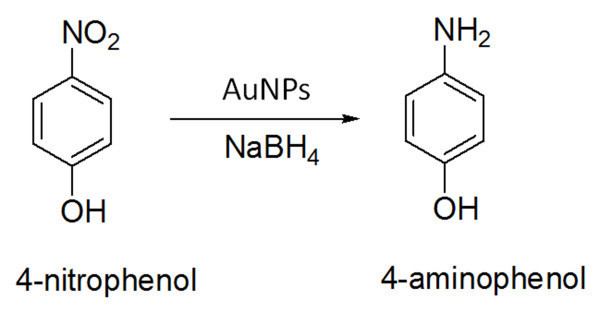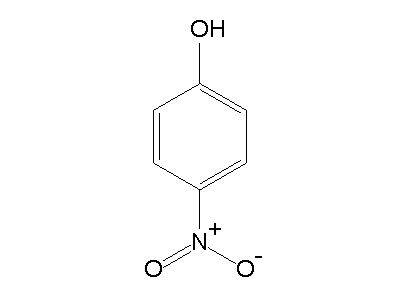Formula C6H5NO3 | ||
 | ||
Appearance Colorless or yellow pillars | ||
4-nitrophenol (also called p-nitrophenol or 4-hydroxynitrobenzene) is a phenolic compound that has a nitro group at the opposite position of the hydroxyl group on the benzene ring.
Contents

Properties

4-nitrophenol shows two polymorphs in the crystalline state. The alpha-form is colorless pillars, unstable at room temperature, and stable toward sunlight. The beta-form is yellow pillars, stable at room temperature, and gradually turns red upon irradiation of sunlight. Usually 4-nitrophenol exists as a mixture of these two forms.
In solution, 4-nitrophenol has a dissociation constant (pKa) of 7.15 at 25 °C.

A solution of 4-nitrophenol appears colourless below pH 5.4, and yellow above pH 7.5. This color-changing property makes this compound useful as a pH indicator. The yellow color of the 4-nitrophenolate form (or 4-nitrophenoxide) is due to a maximum of absorbance at 405 nm (ε = 18.3 to 18.4 mM−1 cm−1 in strong alkali). In contrast, 4-nitrophenol has a weak absorbance at 405 nm (ε = 0.2 mM−1 cm−1). The isosbestic point for 4-nitrophenol/4-nitrophenoxide is at 348 nm, with ε = 5.4 mM−1 cm−1.
Uses

Uses of nitrophenol derivatives

4-nitrophenol is a product of the enzymatic cleavage of several synthetic substrates such as 4-nitrophenyl phosphate (used as a substrate for alkaline phosphatase), 4-nitrophenyl acetate (for carbonic anhydrase), 4-nitrophenyl-β-D-glucopyranoside and other sugar derivatives which are used to assay various glycosidase enzymes. Amounts of 4-nitrophenol produced by a particular enzyme in the presence of its corresponding substrate can be measured with a spectrophotometer at or around 405 nm and used as a proxy measurement for the amount of the enzyme activity in the sample.

Accurate measurement of enzyme activity requires that the 4-nitrophenol product is fully deprotonated, existing as 4-nitrophenolate, given the weak absorbance of 4-nitrophenol at 405 nm (see above). A common mistake in measuring enzyme activity using these substrates is to perform the assays at neutral or acidic pH without considering that only part of the chromophoric product is ionised. The problem can be overcome by stopping the reaction with NaOH or other strong base, which converts all product into 4-nitrophenoxide; final pH must be > ca. 9.2 to ensure more than 99% of the product is ionised. Alternatively enzyme activity can be measured at 348 nm, the isosbestic point for 4-nitrophenol/4-nitrophenoxide (see above).
Toxicity

4-nitrophenol irritates the eyes, skin, and respiratory tract. It may also cause inflammation of those parts. It has a delayed interaction with blood and forms methaemoglobin which is responsible for methemoglobinemia, potentially causing cyanosis, confusion, and unconsciousness. When ingested, it causes abdominal pain and vomiting. Prolonged contact with skin may cause allergic response. Genotoxicity and carcinogenicity of 4-nitrophenol are not known. The LD50 in mice is 282 mg/kg and in rats is 202 mg/kg (p.o.).
